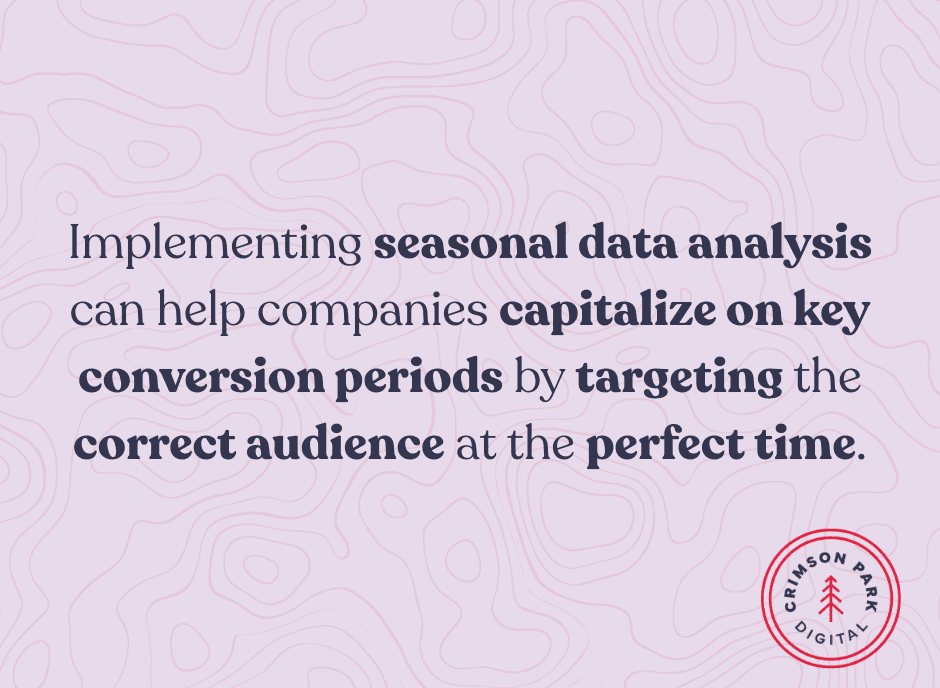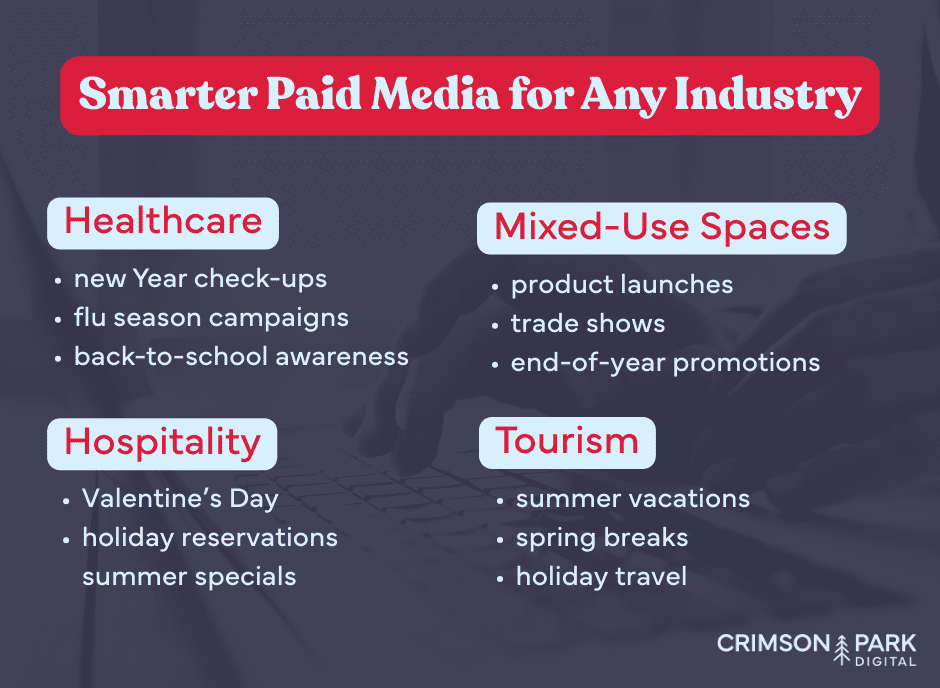Why Seasonal Paid Media Strategies Actually Matter
Here’s the thing. People behave differently at different times of the year. Their moods, interests, and buying habits shift with the seasons. If you plan campaigns around these natural patterns, your marketing hits harder.
Peak periods, like holidays or major sales events, see a spike in activity. For example, search campaigns on Google Ads often experience spikes in healthcare queries in January, while Meta ads shine during the holiday shopping season as people scroll and shop simultaneously. When you match your campaigns to that spike, your messages feel relevant instead of annoying. You’re not just another ad in the feed; you’re the one they’ve been waiting for.

Knowing your audience’s seasonal habits also means you can get creative with messaging and offers. Maybe patients are scheduling check-ups in the new year, tourists are booking summer getaways, diners are hunting for holiday reservations, or commercial tenants are planning end-of-year launches. Understanding these patterns lets your campaigns connect in ways generic ads never could, making your brand feel timely, relevant, and impossible to ignore.
Some perks of seasonal strategies include:
- Riding the wave of audience behavior: Your ads land when people are already primed to engage.
- Boosted engagement during high-traffic times: More eyes, more clicks, more conversions.
- Higher conversion rates: Relevant offers drive real action.
Planning your campaigns around seasonal peaks also helps you stand out in crowded markets. You’re showing up when it matters most and putting every dollar to work.
Build a Year-Round Advertising Campaign Calendar
Chaos is the enemy of effective paid media. A paid media calendar is your secret weapon against it. Think of it like a game plan for the whole year—without one, you’re basically winging it.
Start by mapping out key dates: holidays, industry events, and moments that matter to your audience. Not everything has to be carved in stone. Leave room for unexpected opportunities or trends that pop up during the year.
Your calendar should include:
- Holidays and cultural events relevant to your audience
- Launches or promotions
- seasonal DIY or holiday décor trends can inform timing (great for Pinterest ads)
- campaigns around industry conferences (ideal for LinkedIn Ads)
A calendar isn’t just about marking dates on a page. Update it regularly based on past performance and market shifts. The more responsive it is, the better your campaigns will perform.

Get Into Your Audience’s Seasonal Mindset
Knowing what your audience wants and when they want it is half the battle. Different seasons spark different behaviors.
Dig into historical data to spot trends. Which products perform best at which times? When does engagement spike? Combine this with regional and cultural insights, and you can craft campaigns that feel almost psychic.
Tailoring campaigns to these seasonal behaviors boosts relevance and conversion. Your audience sees what they want, when they want it, and they’re more likely to act.
Learn from Past Advertising Campaigns
If past campaigns could talk, they’d spill all the tea on what works and what flops. Dig into the data and see what performed, what fell short, and why.
Metrics such as conversion rates, click-through rates, and ROI tell you which strategies actually pay off. Break it down by season, creative type, and audience segment. This insight helps fine-tune future campaigns and avoid repeating mistakes.
For example, Google Search may show high CTRs but higher CPCs during competitive holiday weeks, while Microsoft Ads can deliver cheaper CPCs in similar verticals.
Holiday Marketing Done Right
Everyone talks about holiday marketing like it’s a once-a-year frenzy. But, the brands that crush it start planning early. Identify the holidays and events that matter to your audience. Then, get creative.
Limited-time promotions drive urgency, but they need to fit your brand. And don’t just stick to one channel. Mix social, email, and display advertising for maximum reach. Each platform should support the same central message. Brands often combine Meta retargeting ads, Google Display festive creatives, and YouTube bumper ads to stay top of mind during peak shopping weeks.
Essential steps include:
- Set clear goals and KPIs
- Design a timeline for campaign rollout
- Create festive, attention-grabbing visuals
Keep an eye on competitors, too. See what’s trending and find ways to stand out. Being flexible allows you to adjust when consumer behavior shifts or new opportunities pop up.
Channel Selection and Smart Budgeting
Not every platform works for every campaign. Pick the channels your audience actually uses, then focus your budget there. You want to get maximum reach without throwing money into a black hole.
Balance is key. Invest in your proven channels but leave room to experiment with new ones. Monitor performance in real time, then shift budget where it makes sense. Flexibility can turn a good campaign into a great one.
Make Your Messaging Impactful
Seasonal campaigns aren’t just about timing, they’re about feeling. Your messaging should reflect the season while staying true to your brand. Play with seasonal visuals, language, and offers that grab attention without feeling forced.
The best campaigns are authentic. Don’t just slap a holiday motif on a generic ad. Make it feel intentional. That authenticity builds trust and makes your campaign memorable.
Cross-Channel Integration
If your campaigns aren’t working together, you’re leaving money on the table. Align messaging, visuals, and timing across channels. Social, search, and display ads should feel like part of the same story.
Seamless transitions between platforms create a better user experience. The audience sees a consistent message everywhere, which boosts engagement and conversion.
Track Performance and Optimize in Real Time
Data is your best friend. Watch how campaigns perform and make adjustments as needed. ROI, conversion rates, click-through rates, and cost-per-click reveal where to double down and where to pivot.
Optimization isn’t a one-time thing. Seasonal campaigns require constant attention to make sure every dollar works as hard as possible.
How Often Should You Check Your Budget?
Regular reviews are essential. Check your budget quarterly, after big campaigns, or when trends change. This keeps your media spend aligned with business goals and avoids wasting money on underperforming tactics.
However, be mindful that the review cadence can vary by platform; for fast-moving platforms like TikTok or Meta, weekly checks may be essential during seasonal spikes.
Campaign Pitfalls to Avoid
Common mistakes include poor timing, mismatched messaging, and spreading budgets too thin. Avoid these by planning early, staying flexible, and monitoring competitors. Smart seasonal campaigns anticipate these challenges and navigate around them.
Make Every Media Dollar Count
Seasonal paid media strategies can be a game-changer. The main points to remember:
- Understand your audience’s seasonal behaviors
- Learn from past campaigns
- Build a year-round marketing calendar
- Optimize channels and messaging for the season
- Track performance and stay flexible

A strategic approach to seasonal campaigns ensures every media dollar is stretched and every effort counts.
If you want to see how seasonal strategies can work specifically for your brand, schedule a consultation with us today. We’ll help you plan smarter campaigns, maximize ROI, and keep your paid media working harder, not your budget.


